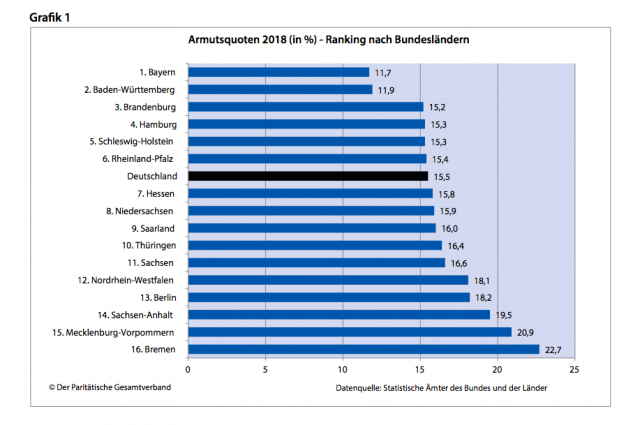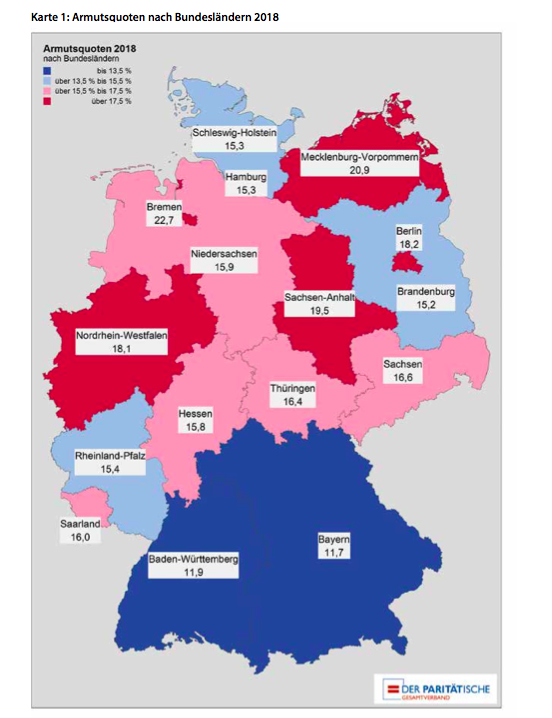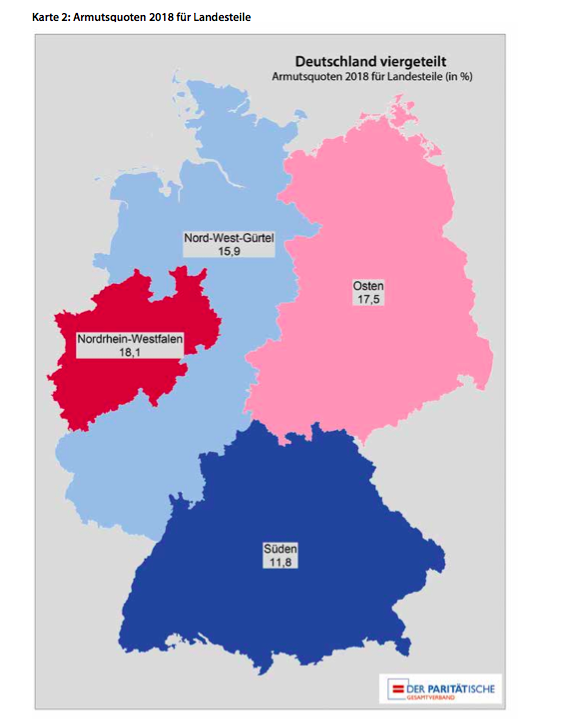Explained: How new poverty ‘problem regions’ are emerging in Germany

Overall poverty is declining slightly in Germany, a new report has found. But there are deep divides and new ‘problem regions’ emerging.
The number of people living in poverty in Germany has dropped slightly, a new report by the Paritätische Wohlfahrtsverband (Parity Welfare Association), has found.
In 2018, 15.5 percent of the population was affected by poverty, a drop of 0.3 percentage points compared to the previous year. It means that 210,000 fewer people were living below the bread line in Germany in 2018 compared to 2017.
Yet there are still big concerns. "Despite a welcome decline in the nationwide poverty rate to 15.5 percent, worrying developments and new problem regions are emerging, particularly in west Germany," the report says.
Someone in Germany is generally deemed to be in poverty if they live in a household with an income below 60 per cent of the current median (or typical) household income, although other factors are taken into account. These are people whose monthly net income is typically less than around €905.
READ ALSO: How Germany plans to fight stark regional inequalities
Large inequalities
The research reveals stark inequalities throughout Germany nearly 30 years after reunification – and shows the divide is not just between eastern and western states.
The poverty rate ranges from 11.7 percent in prosperous Bavaria to 22.7 percent in Bremen, the smallest state in Germany.
Other states with a lower rate of poverty are Brandenburg, with 15.2 percent, as well as Hamburg and Schleswig-Holstein, which both have a 15.3 percent poverty rate.
As the graphic and map below shows, the areas with more problems are in the east of the country (particularly Mecklenburg-Western Pomerania and Saxony-Anhalt) as well as Bremen, Berlin and North Rhine-Westphalia.


Source: Der Paritätische Gesamtverband
'Deeply divided'
Ulrich Schneider, managing director of the Paritätische Gesamtverband, highlighted the problems.
"The gap between affluent regions on the one hand, and poor regions on the other, is growing steadily and clearly, and the divide is no longer just between east and west," said Schneider.
On closer inspection, Germany now appears to be divided into four parts when it comes to poverty. The prosperous South (Bavaria and Baden-Württemberg with a combined poverty rate of 11.8 percent) is contrasted by North Rhine-Westphalia with a poverty rate of 18.1 percent and the east, with a 17.5 percent rate.
The other regions of western Germany have a combined rate of 15.9 percent.
"The poverty report shows that the west of Germany is also deeply divided and far removed from uniformity or equal living conditions," said Schneider.
The below map shows Germany split into four parts.

Source: Der Paritätische Gesamtverband
The study looked at poverty development at national and regional levels. According to the researchers, poverty fell in 35 out of 95 regions between 2008 and 2018, including predominantly eastern German regions.
But in over a quarter of regions, poverty increased by more than 20 percent over the same period. With a poverty rate of 21.1 percent and 5.8 million residents, the Ruhr region (Ruhrgebiet) in North Rhine-Westphalia, Germany's most populated state, remains the "number one problem region", according to the study.
READ ALSO: Poverty rising in Germany's industrial Ruhr region
The industrial area, which includes cities like Dortmund and Essen, was one of Germany's richest throughout the 20th century on the back of a thriving coal mining industry. As the coal mines have closed however, wages have stagnated and poverty has trended upwards in the region.
The study also found a number of new problem regions, which were in a fairly good position in 2008 but now also have poverty rates above the national average.
Researchers pointed to the central state of Hesse where development is particularly poor: whereas 10 years ago the state was on par with the wealthy south, poverty levels in Hesse have risen by 24 per cent since then – an increase higher than in any other state.
Old-age poverty a big worry
There are also concerns about old-age poverty and the so-called 'working poor' in Germany.
The number of pensioners living in poverty has risen by 33 per cent in the last 10 years, an increase unparalleled by any other group. Of the adult poor, 29 per cent are retired and 32 per cent are employed. Meanwhile, every fifth child lives in poverty.
READ ALSO: Old-age poverty in Germany set to rise significantly
In its report, the association calls for, among other things, a "master plan" to tackle poverty that includes looking at housing, care for pensioners, health, family, education and inclusion. Authors want to see an increase of the minimum wage and the rates in Germany's Hartz IV unemployment benefits.
As The Local reported earlier this year, the German government is pledging to tackle poverty and reduce the gap between booming regions and those lagging behind.
Comments
See Also
The number of people living in poverty in Germany has dropped slightly, a new report by the Paritätische Wohlfahrtsverband (Parity Welfare Association), has found.
In 2018, 15.5 percent of the population was affected by poverty, a drop of 0.3 percentage points compared to the previous year. It means that 210,000 fewer people were living below the bread line in Germany in 2018 compared to 2017.
Yet there are still big concerns. "Despite a welcome decline in the nationwide poverty rate to 15.5 percent, worrying developments and new problem regions are emerging, particularly in west Germany," the report says.
Someone in Germany is generally deemed to be in poverty if they live in a household with an income below 60 per cent of the current median (or typical) household income, although other factors are taken into account. These are people whose monthly net income is typically less than around €905.
READ ALSO: How Germany plans to fight stark regional inequalities
Large inequalities
The research reveals stark inequalities throughout Germany nearly 30 years after reunification – and shows the divide is not just between eastern and western states.
The poverty rate ranges from 11.7 percent in prosperous Bavaria to 22.7 percent in Bremen, the smallest state in Germany.
Other states with a lower rate of poverty are Brandenburg, with 15.2 percent, as well as Hamburg and Schleswig-Holstein, which both have a 15.3 percent poverty rate.
As the graphic and map below shows, the areas with more problems are in the east of the country (particularly Mecklenburg-Western Pomerania and Saxony-Anhalt) as well as Bremen, Berlin and North Rhine-Westphalia.


Source: Der Paritätische Gesamtverband
'Deeply divided'
Ulrich Schneider, managing director of the Paritätische Gesamtverband, highlighted the problems.
"The gap between affluent regions on the one hand, and poor regions on the other, is growing steadily and clearly, and the divide is no longer just between east and west," said Schneider.
On closer inspection, Germany now appears to be divided into four parts when it comes to poverty. The prosperous South (Bavaria and Baden-Württemberg with a combined poverty rate of 11.8 percent) is contrasted by North Rhine-Westphalia with a poverty rate of 18.1 percent and the east, with a 17.5 percent rate.
The other regions of western Germany have a combined rate of 15.9 percent.
"The poverty report shows that the west of Germany is also deeply divided and far removed from uniformity or equal living conditions," said Schneider.
The below map shows Germany split into four parts.

Source: Der Paritätische Gesamtverband
The study looked at poverty development at national and regional levels. According to the researchers, poverty fell in 35 out of 95 regions between 2008 and 2018, including predominantly eastern German regions.
But in over a quarter of regions, poverty increased by more than 20 percent over the same period. With a poverty rate of 21.1 percent and 5.8 million residents, the Ruhr region (Ruhrgebiet) in North Rhine-Westphalia, Germany's most populated state, remains the "number one problem region", according to the study.
READ ALSO: Poverty rising in Germany's industrial Ruhr region
The industrial area, which includes cities like Dortmund and Essen, was one of Germany's richest throughout the 20th century on the back of a thriving coal mining industry. As the coal mines have closed however, wages have stagnated and poverty has trended upwards in the region.
The study also found a number of new problem regions, which were in a fairly good position in 2008 but now also have poverty rates above the national average.
Researchers pointed to the central state of Hesse where development is particularly poor: whereas 10 years ago the state was on par with the wealthy south, poverty levels in Hesse have risen by 24 per cent since then – an increase higher than in any other state.
Old-age poverty a big worry
There are also concerns about old-age poverty and the so-called 'working poor' in Germany.
The number of pensioners living in poverty has risen by 33 per cent in the last 10 years, an increase unparalleled by any other group. Of the adult poor, 29 per cent are retired and 32 per cent are employed. Meanwhile, every fifth child lives in poverty.
READ ALSO: Old-age poverty in Germany set to rise significantly
In its report, the association calls for, among other things, a "master plan" to tackle poverty that includes looking at housing, care for pensioners, health, family, education and inclusion. Authors want to see an increase of the minimum wage and the rates in Germany's Hartz IV unemployment benefits.
As The Local reported earlier this year, the German government is pledging to tackle poverty and reduce the gap between booming regions and those lagging behind.
Join the conversation in our comments section below. Share your own views and experience and if you have a question or suggestion for our journalists then email us at [email protected].
Please keep comments civil, constructive and on topic – and make sure to read our terms of use before getting involved.
Please log in here to leave a comment.